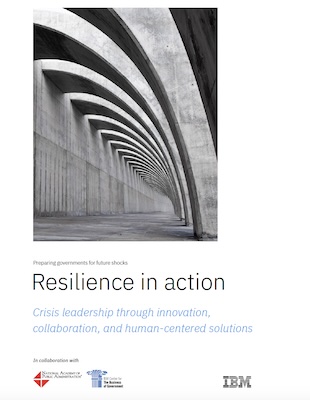
How Can Government Build Resilience in the Face of Crises?

Since the turn of the millennium, pandemics, heat waves, wildfires, floods, cyberattacks, supply chain interruptions, and other crises have deeply stressed governments, communities, businesses, and individuals around the world. This cascade of catastrophic events raises fundamental questions about how governments can anticipate, prepare for, and respond to these and other shocks yet to come.
Shocks transcend geographic, jurisdictional, political, and organizational boundaries. Furthermore, adaptation, preparation, and response to shock events cannot be the responsibility of a single sector, program, agency, or level of government. Instead, the key to success—and the root cause of many failures— lies within the capabilities of individual network participants and the strength of the network before, during, and after an upheaval. Simply put, complex problems cannot be solved in silos.
In an era of unprecedented disruptions, the ability to anticipate future uncertainties and navigate through crises is crucial for leaders in all sectors. Global pandemics, climate change, geopolitical tensions, and other disruptions are testing resilience like never before. A key lesson learned from these challenges is that collaborative, forward-looking planning is essential to safeguard constituents and provide operational continuity.
What practical steps can governments take in the near term to better prepare for and respond to future shocks?
In 2022, the IBM Institute for Business Value (IBM IBV), the IBM Center for The Business of Government (the IBM Center), and the National Academy of Public Administration (the Academy) launched an initiative to help governments identify and develop core capabilities critical to building resilience in five key domain areas: emergency preparedness and response, cybersecurity, supply chain, climate sustainability, and workforce development. Since then, our “Future Shocks” initiative has included expert roundtable discussions, government executive survey research, and a series of reports. (Learn more about our future shocks initiative)
Earlier this year, the IBM Center, IBV, and Academy announced a Challenge Grant competition expanded on this work, through identifying real-world examples of government organizations that have recently implemented strategies and capabilities to improve their mission resilience to be “future ready” and prepared to respond to disruptive events. Respondents offered ideas for case studies within the five key domain areas identified above.
Based on those ideas selected as finalists from the challenge competition, IBM and the Academy have released a new report, Resilience in Action: Crisis Leadership Through Innovation, Collaboration, and Human-Centered Solutions. The report presents four case studies from around the world that demonstrate how innovative strategies and strong partnerships can enhance preparedness. These experiences offer critical insights for government leaders and other stakeholders as they prepare for an increasingly volatile future. They show how public and private entities join forces to address complex challenges, from emergency health coordination to leveraging digital tools for crisis management. And they go beyond technology to explore human factors, including social, organizational, and political dynamics, that should be included in any holistic approach for resilience.
The case studies illustrate leading practices in emergency preparedness and response actions. These examples reflect how strong collaboration and partnerships, coupled with innovative planning methods and advanced technologies, can enhance governmental capacity to prepare for and respond to crises and disruptive events. These cases also illuminate critical success factors that enable government leaders to learn from the teams that implemented these solutions and integrate that knowledge into future planning and preparation efforts.
Key findings from the case studies include:
- The importance of coordination between public and private sector stakeholders before and after a shock-level event happens. Cross-organizational planning is critical to effective response in the aftermath of pandemics, wars, economic crises, and other disruptive events.
- Before a disaster occurs, organizations need to engage in risk assessments, scenario planning, and capacity building exercises to prepare for or mitigate the impact of major disruptions. For example, regular security audits and response drills help strengthen overall preparedness and resilience.
- After a disaster strikes, coordination helps facilitate swift and effective mitigation, including disaster recovery and continuity of operations. This coordination helps essential services rebound quickly and limits long-term damage to critical infrastructure. By integrating before and after approaches, stakeholders can build and manage more resilient systems that can better withstand and recover faster from future crises.
As governments face the ongoing threats of global shocks, we must continue to evolve our strategies and strengthen our collective resilience. The Future Shocks initiative will continue to curate and share examples where governments and global partners have successfully built resilience to shock events.
We would like to thank the authors behind these stories, and we hope the practices they share will inspire and guide leaders across all sectors in building a safer, more resilient future.



